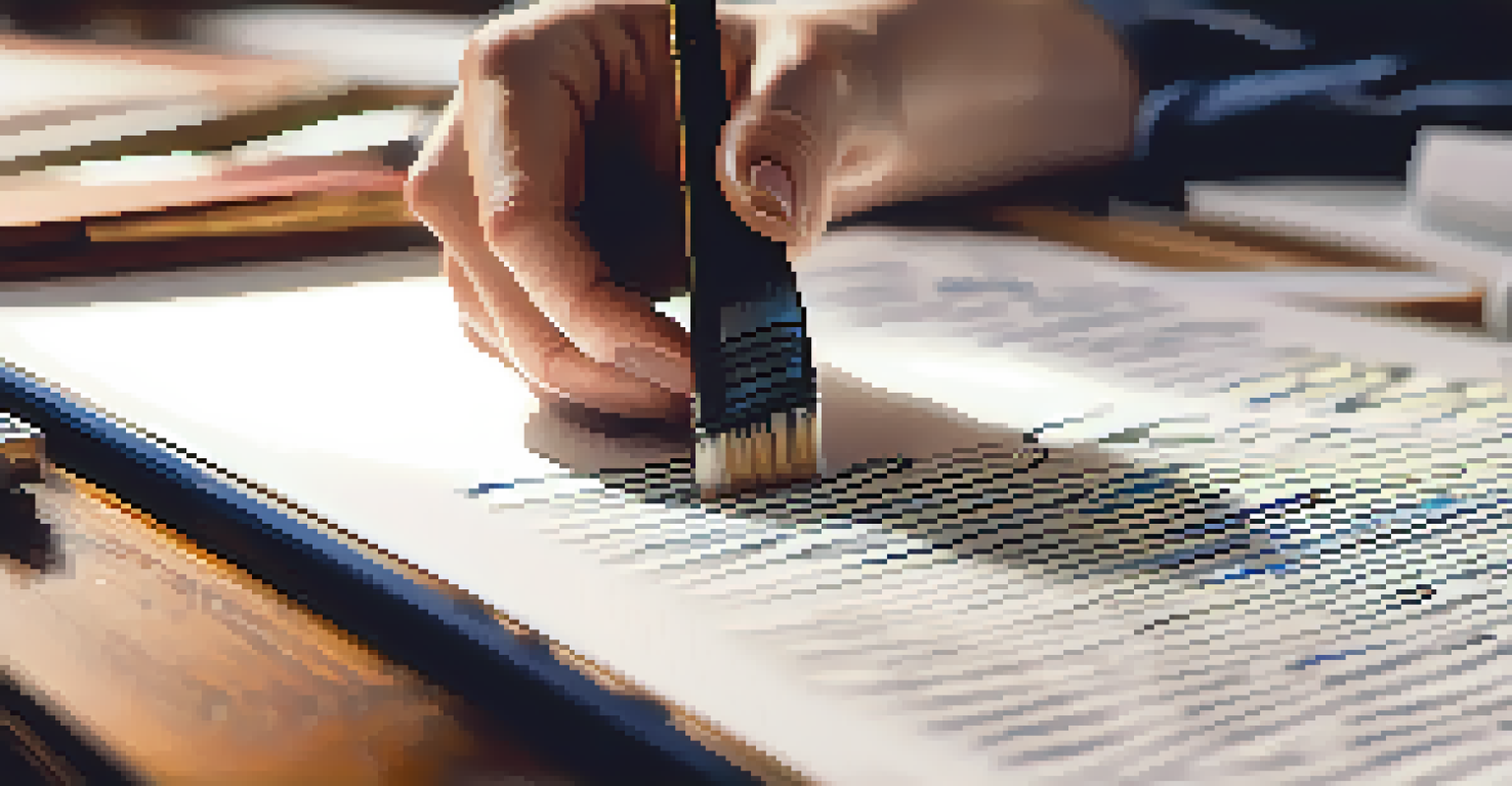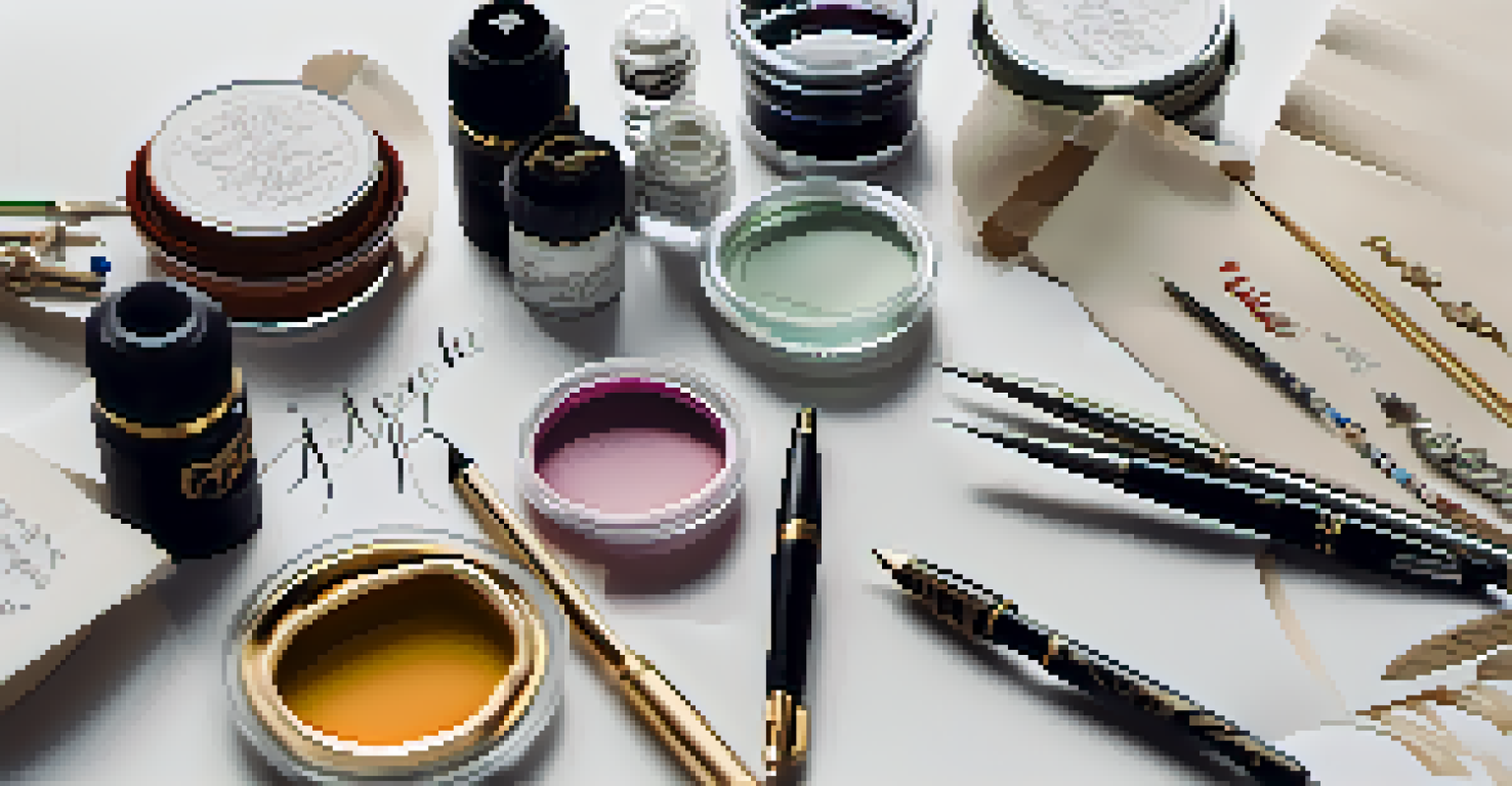Essential Tools for Beginners: Calligraphy Pens and Brushes

Understanding Calligraphy: A Beautiful Art Form
Calligraphy is more than just writing; it's an art form that transforms letters into visually stunning pieces. Known for its expressive and fluid style, calligraphy has a rich history that dates back centuries. This craft can evoke emotions and add a personal touch to any project, whether it's wedding invitations or signage.
Calligraphy is a kind of music not for the ears, but for the eyes.
For beginners, diving into calligraphy can seem daunting, but with the right tools, you can make the learning process enjoyable and rewarding. Using the proper pens and brushes will help you create beautiful lettering and develop your unique style. Understanding the basics will set you on a path to mastering this elegant craft.
In this article, we’ll explore essential tools for budding calligraphers, focusing on various pens and brushes that can help you get started. From nibs to markers, we’ll break down what makes each tool special, ensuring you feel confident as you embark on your calligraphy journey.
Essential Calligraphy Pens for Beginners
When starting with calligraphy, choosing the right pen is crucial for developing your skills. Fountain pens are a popular choice for beginners because they offer flexibility in line thickness and are easy to control. Many fountain pens also allow for a variety of ink types, which can enhance your writing experience.

Another great option is the dip pen, which provides a traditional feel and allows you to experiment with different nibs. The nib is the part of the pen that touches the paper, and different shapes can create various styles of lettering. This versatility makes dip pens a favorite tool for those looking to explore different calligraphy styles.
Calligraphy as an Art Form
Calligraphy transforms letters into beautiful art, adding a personal touch to various projects.
For those seeking convenience, brush pens are an excellent alternative. They combine the control of a pen with the fluidity of a brush, making them ideal for beginners. Brush pens come in various sizes and styles, allowing for a range of lettering effects while being easy to use right out of the box.
Choosing the Right Nib for Your Calligraphy Pen
Nibs come in various shapes and sizes, and selecting the right one can significantly impact your calligraphy style. For beginners, a medium or broad nib is often recommended, as it provides a good balance between control and versatility. A flexible nib can also allow for more expressive strokes, adding character to your letters.
The pen is the tongue of the mind.
It's essential to consider the type of ink you'll use with your nib, as some nibs work better with specific ink types. For instance, if you're using a thicker ink, opt for a nib designed to handle it, as this will prevent clogging and ensure smooth writing. Experimenting with different nibs can help you discover your preferred style and technique.
Don’t forget that practice is key! As you become more comfortable with different nibs, your handwriting will naturally evolve, allowing you to develop your unique flair. So, grab a few different nibs and start experimenting to see which ones resonate with your writing style.
Exploring Brush Pens for Calligraphy
Brush pens are an excellent option for beginners due to their ease of use and versatility. These pens feature soft, flexible tips that allow for both thick and thin strokes, mimicking the effects of traditional brushwork without the mess of paint. They are perfect for those who want to create beautiful calligraphy without the steep learning curve.
One popular choice among beginners is the Tombow Dual Brush Pen, known for its quality and flexibility. With a brush tip on one end and a fine tip on the other, you can easily switch between bold lettering and fine details. This dual functionality makes it an ideal tool for creating stunning calligraphy pieces.
Choosing the Right Tools
Selecting the appropriate pens, brushes, and paper is crucial for developing your calligraphy skills.
In addition to being user-friendly, brush pens come in a variety of colors, allowing you to experiment with different palettes. This means you can create vibrant and personalized projects, whether it's a simple greeting card or a more intricate piece. Brush pens truly open the door to creativity in your calligraphy journey.
Paper Types for Calligraphy Practice
Choosing the right paper is just as important as selecting the right tools for your calligraphy practice. Smooth, high-quality paper will allow your pen or brush to glide effortlessly, preventing any snagging or bleeding. Many beginners prefer using marker paper or calligraphy-specific paper designed to enhance the writing experience.
If you're practicing with a dip pen, consider using a heavier weight paper to prevent ink from bleeding through. Additionally, look for paper with a slight texture, which can help create more interesting strokes and prevent smudging. Test different paper types to discover which ones work best for your style and tools.
Don't forget that practice can be messy! Using scrap paper can help you refine your techniques before committing to your final piece. This way, you can feel free to experiment and make mistakes without the fear of ruining your work.
Essential Accessories to Enhance Your Calligraphy
While pens and brushes are the stars of the show, some essential accessories can elevate your calligraphy practice. A good pencil and eraser are invaluable for sketching out layouts and making adjustments before committing ink to paper. This practice can save you time and frustration as you refine your compositions.
Another handy accessory is a ruler, which can help you maintain consistent spacing and alignment in your lettering. Using a ruler ensures that your work looks polished and professional, even as a beginner. It’s a simple tool that can significantly improve the quality of your calligraphy.
Practice Makes Perfect
Establishing a consistent practice routine is key to improving your calligraphy abilities over time.
Lastly, a calligraphy practice book or guide can offer invaluable tips and exercises to help you hone your skills. These resources often include examples and templates that you can trace, making it easier to understand the nuances of letterforms. Investing in a few key accessories can make your calligraphy journey more enjoyable and productive.
Building a Calligraphy Practice Routine
Consistency is key when it comes to improving your calligraphy skills. Establishing a practice routine can help you stay motivated and focused on your goals. Start by setting aside a specific time each day or week to dedicate to your practice, even if it’s just 15-30 minutes.
During your practice sessions, mix up your activities to keep things fresh. You might spend one session focusing on basic strokes and another on letterforms. This variety will not only enhance your skills but also keep you engaged and excited about your progress.

As you advance, consider setting small, achievable goals for yourself, such as mastering a particular letter or style. Celebrating these milestones can provide a sense of accomplishment and encourage you to continue honing your craft. Remember, the journey of learning calligraphy is just as rewarding as the final results.